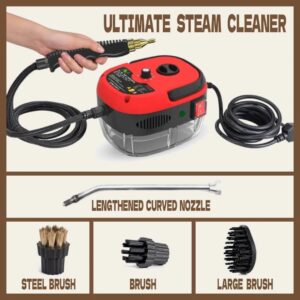
Robotic vacuum cleaner reviews provide a fresh perspective on how these innovative devices have revolutionized our cleaning routines. With a blend of convenience and technology, robotic vacuums have become essential in modern homes, addressing the need for efficient cleaning while saving time for other activities.
This guide delves into the core features that define a top-performing robotic vacuum, alongside insights into their cleaning efficiency on various surfaces, user experiences, and maintenance tips to maximize their performance. Whether you’re a pet owner or simply looking to ease your cleaning burden, understanding these devices can help you make an informed choice.
Robotic Vacuum Cleaner Features
Robotic vacuum cleaners have transformed the way we maintain cleanliness in our homes. With advancements in technology, these devices now offer a range of features designed to enhance their cleaning capabilities, making them more efficient and user-friendly. Understanding these features can help consumers make informed decisions when selecting the right robotic vacuum for their needs.When evaluating a robotic vacuum cleaner, several key features significantly influence its cleaning performance and usability.
One of the most critical aspects is suction power, which determines the effectiveness of dirt and debris removal. Additionally, brush technology plays a vital role in how well a robotic vacuum can navigate different surfaces and handle various types of messes.
Suction Power and Brush Technology
Suction power is a primary factor in the cleaning efficiency of robotic vacuums. A higher suction power rating means that the vacuum can pick up more dirt and pet hair, especially from carpets and rugs. Many modern robotic vacuums are equipped with adjustable suction settings, allowing users to optimize performance based on the surface being cleaned.Brush technology also significantly impacts cleaning efficiency.
Robotic vacuums commonly feature different types of brushes, such as:
- Roller Brushes: Effective for lifting dirt and debris from carpet fibers.
- Side Brushes: Help in reaching corners and edges, ensuring a more thorough clean.
- Rubber Brushes: Designed to reduce tangling and are particularly effective on pet hair.
The combination of powerful suction and advanced brush design leads to a more comprehensive cleaning performance, making it essential to consider both aspects when choosing a robotic vacuum.
Navigation Technologies
The navigation technology utilized by robotic vacuum cleaners is pivotal in determining how well they can cover an area and avoid obstacles. Various systems are employed in robotic vacuums, including:
- Random Navigation: This is a basic method where the vacuum moves in a random pattern. It may miss spots but is generally less expensive.
- Gyroscope Navigation: Helps the vacuum keep track of its location and plan a more efficient cleaning path, but it may still miss some areas.
- Lidar Navigation: Uses laser scanning to create a map of the environment, allowing for precise cleaning paths and obstacle avoidance.
- Camera-Based Navigation: Utilizes cameras to recognize objects and map out the cleaning area, enhancing efficiency and coverage.
Each navigation technology has its advantages and drawbacks. For instance, Lidar navigation is often found in higher-end models and provides excellent mapping capabilities, while random navigation is typical of more budget-friendly options. Selecting the right navigation technology can significantly affect how well a robotic vacuum performs in your home, particularly in areas with complex layouts or obstacles.
Cleaning Performance and Efficiency

Robotic vacuum cleaners have become increasingly popular for their convenience and advanced technology. Understanding how they perform across different floor types and their efficiency in various cleaning tasks is crucial for anyone considering investing in one. This section will delve into the cleaning performance and efficiency of these devices, shedding light on their capabilities and limitations.
Performance on Various Floor Types
Robotic vacuum cleaners are designed to navigate and clean multiple surfaces effectively. Their performance can vary significantly depending on the type of flooring.
Hard Floors
Most robotic vacuums excel on hard surfaces such as tile, laminate, and hardwood. The ability to pick up dust, crumbs, and pet hair is enhanced by their suction power and brush systems designed for such surfaces.
Carpets
Performance on carpets can differ. While many models come equipped with features like increased suction power or brush rollers to handle carpet fibers, thicker carpets may challenge some devices. Lower-profile models might struggle to reach deeper into the carpet fibers, impacting overall cleaning efficacy.
Mixed Environments
Homes with mixed flooring types often require robotic vacuums that can transition seamlessly between surfaces. Models equipped with sensors can automatically adjust suction and brush settings, optimizing cleaning performance and efficiency.
Battery Life and Run Time Significance
The battery life and run time of robotic vacuum cleaners play a vital role in their overall performance. These factors determine how much ground the device can cover before needing a recharge.
Average Run Time
Many robotic vacuums offer a run time of about 60 to 120 minutes, depending on the model and floor type. For instance, higher suction modes may shorten battery life, while eco modes extend the duration, allowing for more extensive cleaning sessions.
Recharge and Resume Features
Some advanced models have the capability to return to their charging dock when the battery runs low and resume cleaning once recharged. This feature is particularly advantageous for larger homes or spaces that require more time to clean effectively.
“Understanding the battery capabilities helps users plan cleaning schedules and ensure thorough coverage of living spaces.”
Effectiveness in Pet Hair Removal
Robotic vacuums have gained a reputation for effectively removing pet hair, which can be a significant concern for pet owners. Compared to standard vacuums, robotic units often provide unique advantages.
Suction Power and Brush Design
Many robotic vacuums feature specialized brushes and strong suction designed specifically for pet hair, minimizing tangles and ensuring a thorough clean. Models equipped with rubberized brushes tend to perform better in this regard, capturing hair more effectively than traditional bristle brushes.
Regular Maintenance
To maintain their efficiency in removing pet hair, regular maintenance is crucial. Emptying dust bins and cleaning brushes can prevent clogs and ensure optimal performance.
User Convenience
The convenience of scheduling cleaning sessions allows pet owners to tackle shedding in real-time. Many users report noticing a reduction in pet hair accumulation with regular robotic vacuum usage.In summary, robotic vacuum cleaners demonstrate strong cleaning performance across various floor types, with battery life and run time being critical factors in their operational efficiency. Their design and technology also make them particularly effective in pet hair removal, often surpassing the capabilities of standard vacuums in this area.
User Experience and Maintenance
Maintaining a robotic vacuum cleaner is essential for ensuring optimal performance and longevity. Users often express their experiences with these devices, revealing both the joys and challenges associated with their use. This guide will provide insights into how to keep your robotic vacuum in top shape, troubleshoot common issues, and share testimonials from real users.
Maintenance Tips for Optimal Performance
Regular maintenance is key to maximizing the efficiency of your robotic vacuum. This involves more than just emptying the dustbin. Here are some crucial steps to keep in mind:
Clean the Brushes and Filters Regularly
Hair and debris can accumulate on brushes and filters, reducing suction power. Clean them every few weeks to maintain peak performance.
Check for Blockages
Inspect the vacuum for any obstructions that could hinder operation. Common blockages include hair tangled in wheels and debris stuck in intake ports.
Keep Sensors Clean
The sensors help your robotic vacuum navigate efficiently. Wipe them gently with a soft cloth to remove dust and smudges.
Charge the Battery Properly
Ensure the vacuum is charged fully before use. Over time, battery life may diminish, so consider replacing it if you notice performance issues.
Update Firmware
Manufacturers often release updates to improve performance and fix bugs. Regularly check for updates through the manufacturer’s app or website.
Troubleshooting Common Issues
Users may face various issues with robotic vacuums, but many can be resolved with simple troubleshooting techniques. Understanding these problems can help enhance the user experience:
Vacuum Not Charging
Check the power source and ensure the charging contacts are clean. If the issue persists, the battery may need replacement.
Sensor Malfunctions
If the device frequently gets stuck or doesn’t navigate correctly, ensure sensors are clean, and there are no obstructions in its path.
Reduced Suction Power
This could indicate a full dustbin or clogged filters. Regularly emptying the dustbin and cleaning the filters will help restore suction.
Robot Gets Stuck
If the vacuum often finds itself stuck, consider area modifications, such as moving furniture or using boundary strips to keep it in open spaces.
User Testimonials on Robotic Vacuums
User experiences vary across different brands and models, shedding light on what works and what doesn’t. Here are some testimonials highlighting real-life experiences:
“I love my Roomba! It navigates my home effortlessly and picks up everything from pet hair to dust. However, I have to clean the brushes regularly or it loses suction.”
– Sarah J., Cat Owner
“The Ecovacs DEEBOT has been a game changer for my family. It covers large areas and has a great battery life, but I did have to troubleshoot a few sensor issues at first.”
– Mark T., Busy Parent
“I switched to Roborock, and I’m impressed with its mapping capabilities. However, it’s crucial to keep the sensors clean, or it will miss spots.”
– Lisa H., HomeownerThese testimonials illustrate the diverse experiences users have with their robotic vacuums, emphasizing the importance of maintenance and the occasional troubleshooting required to enhance performance.
Summary

In conclusion, robotic vacuum cleaner reviews shed light on the significant advancements and features that make these gadgets a worthwhile investment. As technology continues to evolve, these devices not only simplify cleaning tasks but also cater to diverse household needs, from pet hair management to advanced navigation. By understanding the ins and outs of these cleaners, you can confidently choose the right model that fits your lifestyle.
FAQ Corner
What features should I look for in a robotic vacuum?
Key features include suction power, brush technology, navigation systems, and battery life.
Can robotic vacuums handle pet hair effectively?
Yes, many robotic vacuums are specifically designed with features that enhance their ability to pick up pet hair.
How do I maintain my robotic vacuum?
Regularly clean the brushes, empty the dustbin, and check for software updates to keep it functioning optimally.
Are robotic vacuums suitable for all floor types?
Most robotic vacuums perform well on various surfaces like hardwood, carpets, and tiles, although performance may vary by model.
How long does the battery last on a robotic vacuum?
Battery life typically ranges from 60 to 120 minutes, depending on the model and cleaning mode used.




